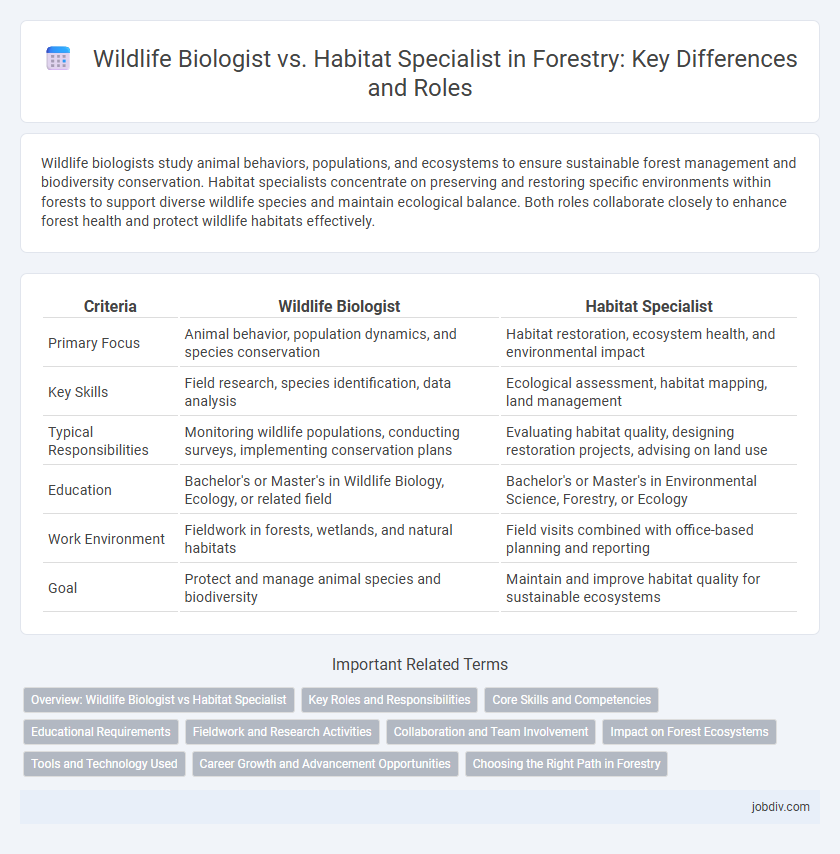Wildlife biologists study animal behaviors, populations, and ecosystems to ensure sustainable forest management and biodiversity conservation. Habitat specialists concentrate on preserving and restoring specific environments within forests to support diverse wildlife species and maintain ecological balance. Both roles collaborate closely to enhance forest health and protect wildlife habitats effectively.
Table of Comparison
| Criteria | Wildlife Biologist | Habitat Specialist |
|---|---|---|
| Primary Focus | Animal behavior, population dynamics, and species conservation | Habitat restoration, ecosystem health, and environmental impact |
| Key Skills | Field research, species identification, data analysis | Ecological assessment, habitat mapping, land management |
| Typical Responsibilities | Monitoring wildlife populations, conducting surveys, implementing conservation plans | Evaluating habitat quality, designing restoration projects, advising on land use |
| Education | Bachelor's or Master's in Wildlife Biology, Ecology, or related field | Bachelor's or Master's in Environmental Science, Forestry, or Ecology |
| Work Environment | Fieldwork in forests, wetlands, and natural habitats | Field visits combined with office-based planning and reporting |
| Goal | Protect and manage animal species and biodiversity | Maintain and improve habitat quality for sustainable ecosystems |
Overview: Wildlife Biologist vs Habitat Specialist
Wildlife biologists study animal species' behavior, population dynamics, and ecological interactions to inform conservation efforts, often conducting field research and data analysis. Habitat specialists focus on the management and restoration of specific ecosystems, ensuring suitable conditions for target species by addressing habitat quality, vegetation, and environmental factors. Both roles collaborate to enhance biodiversity, with wildlife biologists providing species-specific insights and habitat specialists tailoring environments to support those species.
Key Roles and Responsibilities
Wildlife biologists conduct population surveys, analyze animal behavior, and develop conservation plans to preserve species diversity within forest ecosystems. Habitat specialists focus on restoring and managing critical habitats by assessing vegetation health, implementing invasive species control, and ensuring suitable living conditions for native wildlife. Both roles collaborate to balance ecosystem health and biodiversity through targeted research and adaptive management strategies.
Core Skills and Competencies
Wildlife biologists possess core skills in animal behavior analysis, population monitoring, and ecological research methods essential for studying wildlife species in their natural environments. Habitat specialists focus on competencies such as habitat assessment, vegetation management, and restoration techniques crucial for maintaining and improving ecosystem health. Both roles require proficiency in data collection, GIS mapping, and environmental regulations to effectively support conservation efforts and sustainable forestry management.
Educational Requirements
Wildlife biologists typically require a bachelor's degree in wildlife biology, ecology, or a related field, with many positions favoring a master's degree for advanced research roles. Habitat specialists often need similar educational backgrounds but may focus more on forestry, environmental science, or land management degrees, emphasizing ecosystem restoration and habitat conservation techniques. Both careers benefit from field experience and specialized certifications in wildlife management or habitat assessment.
Fieldwork and Research Activities
Wildlife biologists focus on studying animal behavior, populations, and ecosystems through extensive fieldwork involving tracking, sampling, and monitoring species in their natural habitats. Habitat specialists concentrate on assessing and managing the physical environment, conducting vegetation surveys, soil analysis, and habitat restoration projects to ensure sustainable ecosystems. Both roles prioritize data collection and analysis, but wildlife biologists emphasize animal-centric research while habitat specialists target habitat conditions and resource management.
Collaboration and Team Involvement
Wildlife Biologists and Habitat Specialists collaborate closely to enhance ecosystem management, combining expertise in species behavior and habitat conditions. Their teamwork drives the development of comprehensive conservation strategies, ensuring balanced biodiversity and sustainable forestry practices. Active involvement in multidisciplinary teams allows integration of scientific research with practical habitat restoration efforts.
Impact on Forest Ecosystems
Wildlife biologists study animal species' behavior, population dynamics, and ecological roles, influencing forest ecosystem management through data-driven conservation strategies. Habitat specialists focus on preserving and restoring specific forest habitats, ensuring the survival of specialized flora and fauna by maintaining ecosystem balance and biodiversity. Their combined expertise supports sustainable forestry practices that protect wildlife habitats while promoting forest health and resilience.
Tools and Technology Used
Wildlife biologists often utilize GPS tracking collars, remote sensing drones, and camera traps to monitor animal movements and behaviors in forest ecosystems. Habitat specialists employ geographic information systems (GIS), soil sampling kits, and vegetation analysis software to assess and manage habitat quality and restoration efforts. Both professions integrate advanced data analytics and environmental sensors to support sustainable forestry and biodiversity conservation.
Career Growth and Advancement Opportunities
Wildlife biologists often experience broader career growth due to their extensive research roles and opportunities in conservation projects, government agencies, and academia. Habitat specialists tend to advance through niche expertise in ecosystem management, often securing leadership positions in habitat restoration and environmental consulting firms. Both career paths offer unique advancement prospects, with wildlife biologists frequently moving into policy development while habitat specialists excel in field project management.
Choosing the Right Path in Forestry
Wildlife biologists in forestry focus on studying animal behavior, population dynamics, and ecosystem interactions to inform conservation strategies, while habitat specialists concentrate on managing and restoring specific habitats to support biodiversity and ecosystem health. Selecting the right path involves assessing your passion for either direct wildlife research or habitat design and management, as well as considering career goals in fieldwork intensity and specialization. Both roles are integral to sustainable forestry practices, requiring strong ecological knowledge and commitment to environmental stewardship.
Wildlife Biologist vs Habitat Specialist Infographic

 jobdiv.com
jobdiv.com